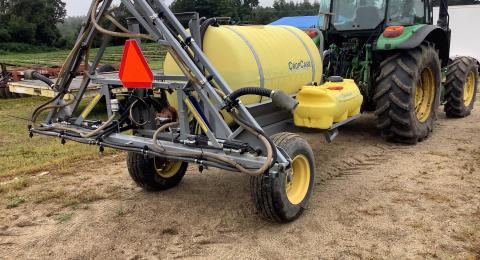The low-pressure boom sprayer is one of the most common types of sprayers, particularly common for herbicide application. It is used when making applications to field vegetable and small fruit crops, meadows, turf, right-of-way, etc. This type of sprayer is useful anywhere you want a uniform application across the soil or plant surface. Proper calibration of this equipment is necessary to ensure uniform and economical application, free of overdoses and skips. The proper care and maintenance of this equipment will ensure the availability of a sprayer that is free of residue and of serviceable condition when needed. One should never operate a sprayer without first checking the calibration. Calibration enables the operator to:
- Determine the precise rate of material applied per acre.
- Ensure uniform application from all nozzle tips to ensure each of the nozzle tips are operating at the manufacturer's specification.
- Compensate for equipment changes, crop staging, and environmental conditions.
- Determine the change in delivery rate when old worn parts have been replaced.
- Compensate for changes in delivery when switching from one spray material or formulation to another. Chemical sprays or fertilizer solutions may show a 5 to 10% difference in output as compared to clear water.
Proper sprayer calibration is one of the most important steps in any integrated pest management program. Sprayer calibration is not complicated or time consuming.
Calibrate low-pressure boom sprayers:
- at the beginning of each season
- mid-way through each season as crops grow and fill in
- after changes to application equipment or settings (e.g., nozzles, operating pressure, pump, tractor, or tractor tires)
Calibration Factors Affecting Application Rate
Ground Speed
Most spray applications with low pressure boom-type sprayers will be made at a speed of 3-5 miles per hour. Many fields in New Hampshire are not suited for speeds greater than 3 mph due to slope, size and irregular terrain. The swaying and bouncing of spray booms will result in uneven application and damage to the booms and hoses. A uniform ground speed is necessary to maintain even spray application.
The spray application per acre varies inversely with the ground speed of the sprayer. If the ground speed is doubled, the application rate is cut in half and as the ground speed is reduced to half, the spray application is doubled. (Note: the speedometer may be inaccurate due to ground conditions, after-market tires, worn tires, etc.)
To measure ground speed, lay out a distance in the field to be sprayed. A distance of 200 to 350 feet is adequate for speeds of 3-5 mph, but 264 feet makes the math easier.
When calculating miles per hour (MPH), always have the spray tank half full. Select a gear and throttle setting that you will use in the field with a loaded spray tank and note these settings for use while calibrating and spraying the field.
Note the time it takes to travel between two stakes 264 feet apart. Repeat the process in the opposite direction and note the average time in seconds. Repeat process again if the time differs by 2 seconds or more.
To calculate ground speed:
Speed (MPH) = distance traveled (FEET) x 60*
average time (SECONDS) x 88*
*88 feet in 60 seconds equals 1 mph.
Example: 44 seconds were required to travel the distance in the first pass, and 46 seconds were required on the return pass of 264 feet. Average of 45 seconds per pass is calculated.
Speed (MPH) = 264 feet x 60 = 15840 = 4.0 MPH
45 seconds x 88 3960
Nozzle Flow Rate
The flow rate through the nozzle varies with the tip type and size, the pressure applied and the condition of the tip. The greatest flow rate results from (1) a larger tip size or (2) a worn tip. Very minor adjustments in the flow rate can be obtained by varying the pressure. Increasing the pressure by 4 times doubles the flow rate. Note that spray equipment manufacturers recommend a specific pressure at which a tip will deliver the designed spray rate and pattern. The spray pressure used may vary for some spray materials. While a pressure of 20 to 40 psi is desirable for most pesticides, a maximum of 20 psi is labeled for other products. Some pesticide labels may call for a slightly higher pressure in some applications to enhance coverage on a heavy plant canopy or heavy weed growth.
One Minute Method of Calibration of a Low-Pressure Boom Sprayer
Use the corresponding worksheet, Boom Sprayer Calibration: 1-Minute Method, to record your calculations and results.
- Make sure all tips and components installed on the boom are of the same size and design. Record type and size of each spray tip.
- Collect spray from each nozzle for exactly 1 minute while operating the sprayer in place at a desired operating pressure. Measure the ounces of spray collected from each nozzle using a calibration jar or a container marked in ounces. Record the volumes.
- Convert the output volume for each nozzle from ounces to gallons by dividing the number of ounces by 128. Then calculate the total output, in gallons, of all nozzles. Because you collected output for exactly one minute, the total collected is the total output in gallons per minute.
- Compare the output of each nozzle to the average of all nozzles. If any nozzle delivers 10 percent more or less than the average, that tip should be inspected for dirt, wear or damage. Clean or replace that tip, then repeat the collection for 1 minute. If the average output is 15 percent more than the output of a new nozzle (as indicated in the manufacturer's chart or discharge test), replace all the nozzles.
- Following the calculations in the accompanying worksheet, use your sprayer's swath width and the speed in miles per hour calculated previously, to calculate the total sprayer output in gallons per acre (GPA).
Apply commercial product(s) at the recommended rate per acre, using the calculated gallons per acre spray rate.
Maintenance of the Sprayer
The following practices will prolong the life of the sprayer:
- Remove and clean the nozzles and filters/strainers and flush sprayerʼs plumbing system with clean water before using a different spray material.
- Do not use any metal object when cleaning sprayer tips. Use a soft brush and can of compressed air.
- Never apply corrosive or abrasive fertilizer solutions through a pesticide sprayer.
- Remove and clean filters/strainers after 10-15 hours of use, better yet, clean every time you fill the sprayer.
Cleaning the Sprayer
Follow directions on the spray material labels for cleaning the sprayer.
- Clean sprayer according to the spray material that was used last.
- Use clean water.
- Use three thorough rinses with water and detergent.
- Clean materials from the sprayer filters/strainers and tips and the lines are flushed.
- Place tips and screens in a jar of hot water with detergent for an hour.
Calibration Notes
Maintaining accurate records is essential to the calibration optimization process. Once you have adjusted your sprayer to the correct calibration, write down the settings (along with the date and time of testing) so that you can use the optimized settings in the future. This is especially helpful if something is lost or your sprayer is repaired. By having a record, you can compare your sprayer calibration calculations from one calibration to the next.
| Date | |||
| Tractor | |||
| Tractor Engine RPM | |||
| Sprayer Pressure PSI | |||
| Tip Size | |||
| Gallons Per Acre | |||
| Speed MPH |
Additional Resources
- Boom Sprayer Calibration Worksheet - One-Minute Method
- Boom Weed Sprayer Calibration Worksheet - One-Minute Method
- Boom Sprayer Calibration Worksheet - 1/128th Method
- Boom Sprayers - How to Optimize Spray Distribution
About the Author
George Hamilton is a retired UNH Cooperative Extension Field Specialist in agriculture dealing with fruit and vegetable production. Fact sheet updated November 2023.
Original fact sheet developed by James R. Mitchell, Extension Specialist, emeritus, Agronomy and George Hamilton, Extension Educator, Agricultural Resources, March 1996.
UNH EXTENSION'S FOOD AND AGRICULTURE PROGRAM
As a component of Extension's Food & Agriculture Program, Extension specialists provide educational resources, training programs, and direct technical assistance for private and commercial pesticide applicators.
Extension Services & Tools That Help NH Farmers Grow
Newsletters: Choose from our many newsletters for production agriculture
Receive Pest Text Alerts - Text UNHIPM to (866) 645-7010


